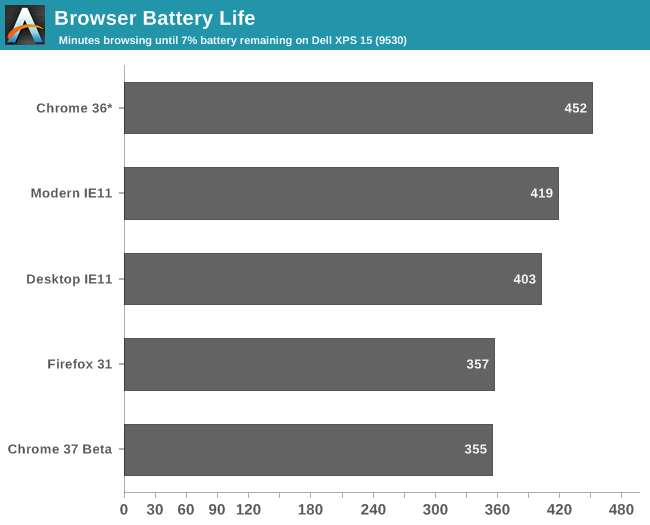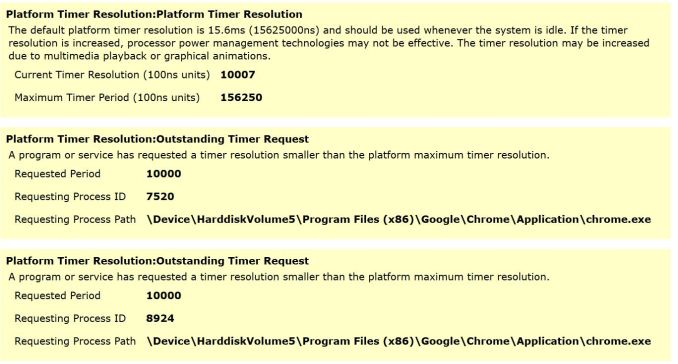Browser Face-Off: Battery Life Explored 2014
by Stephen Barrett on August 12, 2014 6:00 AM ESTResults and Analysis
There is a lot to talk about with these results. While Google Chrome's 1ms timer request certainly uses more power than otherwise, everything else about Google Chrome seems to make up the difference -- at least for Chrome 36. Unfortunately, Chrome 37 takes a dive of almost 25% placing it roughly tied for last place with Firefox. Considering Chrome 36 and Safari are the only browsers on our list that do not support HiDPI displays, that could be the difference. I have added an asterisk on the chart to indicate Chrome 36 is not quite doing the same work as the other browsers. There seems to be a significant battery penalty when natively rendering at 3200x1800 instead of 1600x900 and then scaling up via Windows.

It would be interesting to repeat this test on a lower resolution display, but that would be largely academic, as many laptops today ship with HiDPI displays and more are always on the way. To be honest, I'm not sure anyone could actually use Chrome 36 on a HiDPI display without going crazy anyway, so the fact that Chrome 36 leads the pack here is probably irrelevant.
Update: Chrome has been tested at 1600x900
Just to confirm, I did run a powercfg /energy report and Google Chrome was indeed requesting the high resolution timer.
Energy report while Google Chrome was browsing our test web sites
A few of our test websites also contain flash advertisements, so I was curious if these also caused Firefox and IE11 to increase their timers. Running the same powercfg /energy report did not show any timer increase for those browsers.
Energy report while Firefox or IE11 were browsing our test web sites
As for Safari, unfortunately the browser was having all kinds of trouble being automated by our test suite. The browser window would lose focus every ten seconds and result in lost keyboard inputs. Looking into task manager, whenever Safari would lose focus "Windows Error Reporting" would appear in the processes list. After disabling the Windows Error Reporting Service, Safari instead threw unhandled exceptions every 10 seconds.

Tough to automate a program that throws errors every 10 seconds...
Apple's website does not list any known issues regarding this error. Disabling display scaling, running at 1600x900 resolution, and reinstalling Safari did not resolve the issue. Considering Safari for Windows is still on version 5.1.7 from over two years ago and apparently won't be receiving any further updates, we decided it was best to simply exclude the browser from any further testing.












112 Comments
View All Comments
SanX - Wednesday, August 13, 2014 - link
Linux market share was below 1% for almost two decades.fokka - Tuesday, August 12, 2014 - link
i find it slightly worrying that firefox is tied last in this test. ff has been my browser of choice for years and using anything else than my nicely customized setup makes web-browsing less comfortable than what i'm used to. but getting an hour more battery life out of my aging laptop when away from the socket wouldn't be bad either.maybe i'll give chrome (or one of its derivatives) another chance and try to set it up to my liking as good as i can. we'll see.
CaedenV - Tuesday, August 12, 2014 - link
Mozilla has not managed to put out anything good recently. The last few years they have been playing a 'me too' game with Chrome, to the point now where they even look similar. Outside of that FF has gotten slow, fat, and buggy. Unless you have privacy concerns or pet plugins that only work with FF then it is time to move on to Chrome or IE.And the issue is not limited to their browser. I mean look at the FF Phone and some of their other recent projects... sad to see a traditionally good company flounder like this.
edzieba - Tuesday, August 12, 2014 - link
You could also try something like Palemoon, which is essentially firefox's core but with some of the more dubious UI decisions removed or reversible and a lot of legacy crud cleared out.asmian - Thursday, August 14, 2014 - link
+1 for Palemoon!After reading this post I was curious. I just transferred, migrating my Firefox profile with the tool available to Palemoon with absolutely no issues, and apart from some minor preference tweaks to the toolbars it's a virtually identical browsing experience but I can immediately see and feel the difference in faster page loading. All my extensions and stored passwords work right including FireFTP and site logins. And I'm now running 64-bit, unlike FF. Awesome. ;)
Since the major principle of Palemoon is to cut unnecessary code from the stock FF source to speed up page rendering, it is exactly the sort of alternative browser that should have been included in this test for comparison, since it is now so divergent from official FireFox. Especially since the prevailing logic seems to be "Chrome wins, but sucks for privacy" and Palemoon, from my reading and so far happy experience, doesn't compromise on either.
lilmoe - Tuesday, August 12, 2014 - link
I find your results rather interesting. So I have a question please.Which GPU was primarily active during your tests for hardware accelerated browsers (like IE) vs Chrome? IE is significantly more hardware accelerated, and therefore GPU intensive, than any other browser (on Windows). So it would be interesting to see if the dGPU was taxed during the test.
lilmoe - Tuesday, August 12, 2014 - link
Sorry, forgot to note one more thing. When hardware accelerated rendering is disabled in IE, I noticed a significant reduction in GPU load % VS enabled. I have the same CPU as the test in this benchmark (Core i7 4702MQ, but with an AMD dGPU), and strangely, even CPU power is reduced when GPU rendering is disabled. This wasn't the case in my previous laptop's case (Core 2 Duo), but it's interesting to note. The better your CPU, the less more inefficient GPU rendering becomes.lilmoe - Tuesday, August 12, 2014 - link
the more inefficient**(please add an edit button for our posts...)
Stephen Barrett - Tuesday, August 12, 2014 - link
All browsers used the integrated (Intel) GPUBillBear - Tuesday, August 12, 2014 - link
Since Apple made power efficiency a headline feature of the current version of Safari on OSX Mavericks, I would like to see how that tests out in the real world.Run the same test on a Retina Macbook Pro.